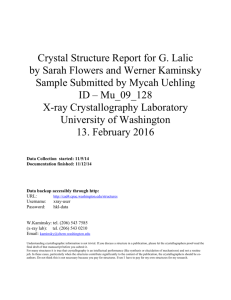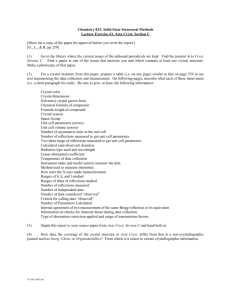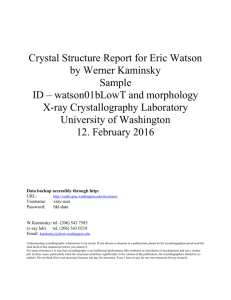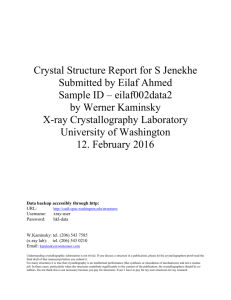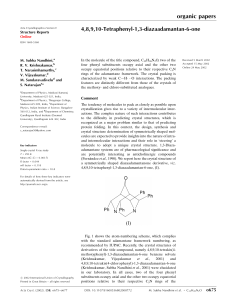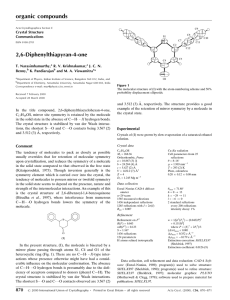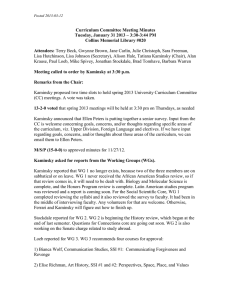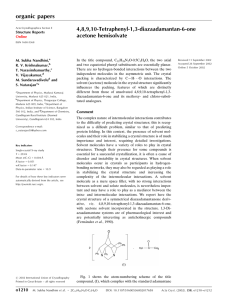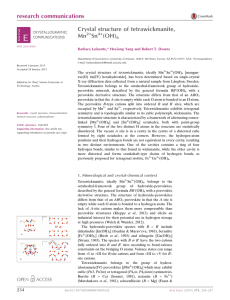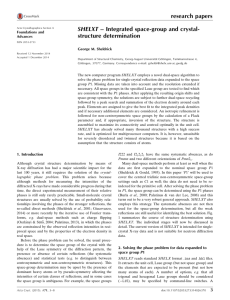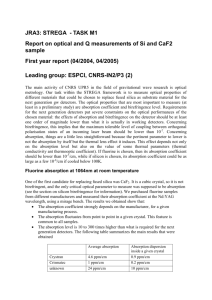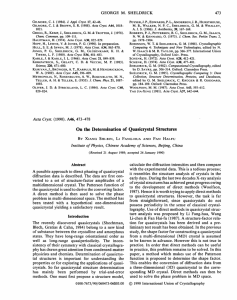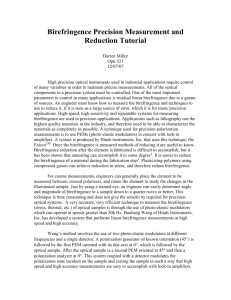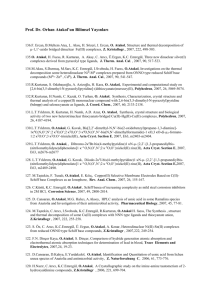Crystal Structure Report for J
advertisement
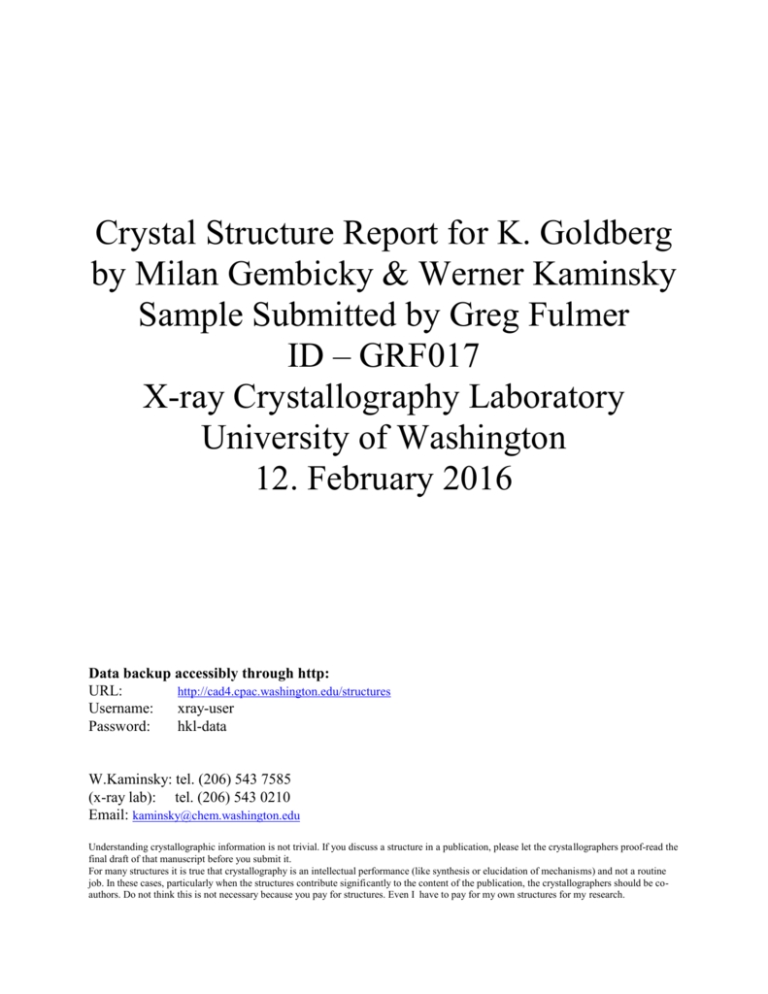
Crystal Structure Report for K. Goldberg by Milan Gembicky & Werner Kaminsky Sample Submitted by Greg Fulmer ID – GRF017 X-ray Crystallography Laboratory University of Washington 12. February 2016 Data backup accessibly through http: URL: http://cad4.cpac.washington.edu/structures Username: xray-user Password: hkl-data W.Kaminsky: tel. (206) 543 7585 (x-ray lab): tel. (206) 543 0210 Email: kaminsky@chem.washington.edu Understanding crystallographic information is not trivial. If you discuss a structure in a publication, please let the crystallographers proof-read the final draft of that manuscript before you submit it. For many structures it is true that crystallography is an intellectual performance (like synthesis or elucidation of mechanisms) and not a routine job. In these cases, particularly when the structures contribute significantly to the content of the publication, the crystallographers should be coauthors. Do not think this is not necessary because you pay for structures. Even I have to pay for my own structures for my research. From a batch of orange spherulites and some clear material was taken a colorless, twinned prism, measuring 0.15 x 0.07 x 0.04 mm3 which was mounted on a glass capillary with oil. Data was collected at -173oC on a Bruker APEX II single crystal X-ray diffractometer, Mo-radiation. Crystal-to-detector distance was 40 mm and exposure time was 10 seconds per degree for all sets. The scan width was 0.5o. Data collection was 94.2% complete to 25o in . The sample (Figure 1) showed concave interceptions on its edges which are typical signs of twinning. Additionally, twinning was indicated by the heterogeneity of birefringence and optical eigenray directions across the sample. Figure 1. Crystal with signs of twinning, seen in (from left to right) transmission, birefringence and extinction1. The raw data appeared indeed twinned. With CELL_NOW2 a 6o twin operation about (0.745 0.131 1.000) or [1.000 -0.655 0.680], consistent with a contact-mirror twin, as seen in Figure 1, was found which, if unresolved, would cause considerable overlap of diffraction peak intensities from different domains of the sample. Multi-domain integration with SAINT within the APEX2 software package by Bruker3 and absorption correction with twinabs4 removed the overlap. A total of 5771 (merged) reflections were collected with 2947 symmetry independent reflections covering the indices, h = -10 to 10, k = -11 to 11, l = -14 to 14 with Rint = 0.0424 indicated that the twin-refined data was good (average quality 0.07). Indexing and unit cell refinement indicated then a triclinic P lattice. The space group was found to be P1 (No.2). Solution by direct methods (SHELXS, SIR975) produced a complete heavy atom phasing model consistent with the proposed structure. The structure was completed by difference Fourier synthesis with SHELXL97.6,7 Scattering factors are from Waasmair and Kirfel8. Hydrogen atoms were placed in geometrically idealised positions and constrained to ride on their parent atoms with CH distances in the range 0.951.00 Angstrom. Isotropic thermal parameters Ueq were fixed such that they were 1.2Ueq of their parent atom Ueq for CH's and 1.5Ueq of their parent atom Ueq in case of methyl groups. All non-hydrogen atoms were refined anisotropically by full-matrix least-squares The structure is chemically disordered favoring the carboxylic ligand 3:2 over the C=O complex, which leads to 4 possible dimer configurations (Figure 2) The structure is of high quality and ready for publication. Table 1 summarizes the data collection details. Figure 2 shows an ORTEP9 of the asymmetric unit with thermal ellipsoids at the 50% probability. Table 1: Crystallographic data for the structures provided. Identification code Empirical formula Formula weight Temperature Wavelength Crystal system Space group Unit cell dimensions Volume Z Density (calculated) Absorption coefficient F(000) Crystal size Theta range for data collection Index ranges Reflections collected Independent reflections Completeness to theta = 25.00° Max. and min. transmission Refinement method Data / restraints / parameters Goodness-of-fit on F2 Final R indices [I>2sigma(I)] R indices (all data) Largest diff. peak and hole twin4_2 C36 H56 O5.16 P2 Pd 739.71 100(2) K 0.71073 Å Triclinic P -1 a = 8.4191(4) Å = 71.585(2)°. b = 9.7162(4) Å = 70.990(3)°. c = 11.8675(5) Å = 73.491(2)°. 852.87(6) Å3 1 1.440 Mg/m3 0.680 mm-1 389.6 0.15 x 0.07 x 0.04 mm3 2.26 to 25.35°. -10<=h<=10, -11<=k<=11, -14<=l<=14 5771 2947 [R(int) = 0.0424] 94.2 % 0.9733 and 0.9049 Full-matrix least-squares on F2 2947 / 96 / 273 1.146 R1 = 0.0528, wR2 = 0.1043 R1 = 0.0726, wR2 = 0.1095 0.722 and -0.723 e.Å-3 1 W. Kaminsky, E. Gunn, R. Sours, B. Kahr: Simultaneous false-color imaging of birefringence, extinction, and transmittance at camera speed. J Microscopy. 228 (2008) 153-164. W. Kaminsky: Real-time linear-birefringence-detecting polarization microscope. April 21st 2009, US Patent 7522278. 2 Sheldrick, G. M. (2005). CELL_NOW. University of Goettingen, Germany. 3 Bruker (2007) APEX2 (Version 2.1-4), SAINT (version 7.34A), SADABS (version 2007/4), BrukerAXS Inc, Madison, Wisconsin, USA. 4 Sheldrick, G. M. (2007). TWINABS. University of Goettingen, Germany. 5 (a) Altomare, A.; Burla, C.; Camalli M.; Cascarano L.; Giacovazzo C.; Guagliardi A.; Moliterni A.G.G.; Polidori G.; Spagna R. J. Appl. Cryst. 1999, 32, 115-119; (b) Altomare, A., Cascarano, G., Giacovazzo, C., Guagliardi, A., J. Appl. Cryst. 1993, 26, 343. 6 Sheldrick, G. M. SHELXL-97: Program for the Refinement of Crystal Structures 1997 University of Gottingen, Germany. 7 Mackay, S.; Edwards, C.; Henderson, A.; Gilmore, C.; Stewart, N.; Shankland, K.; Donald, A.; MaXus: a computer program for the solution and refinement of crystal structures from diffraction data. University of Glasgow, Scotland, 1997. 8 Waasmaier, D.; Kirfel, A. Acta Crystallogr. A. 1995, 51, 416. 9 Farrugia, L. J. Appl. Cryst. 1997, 30, 565
